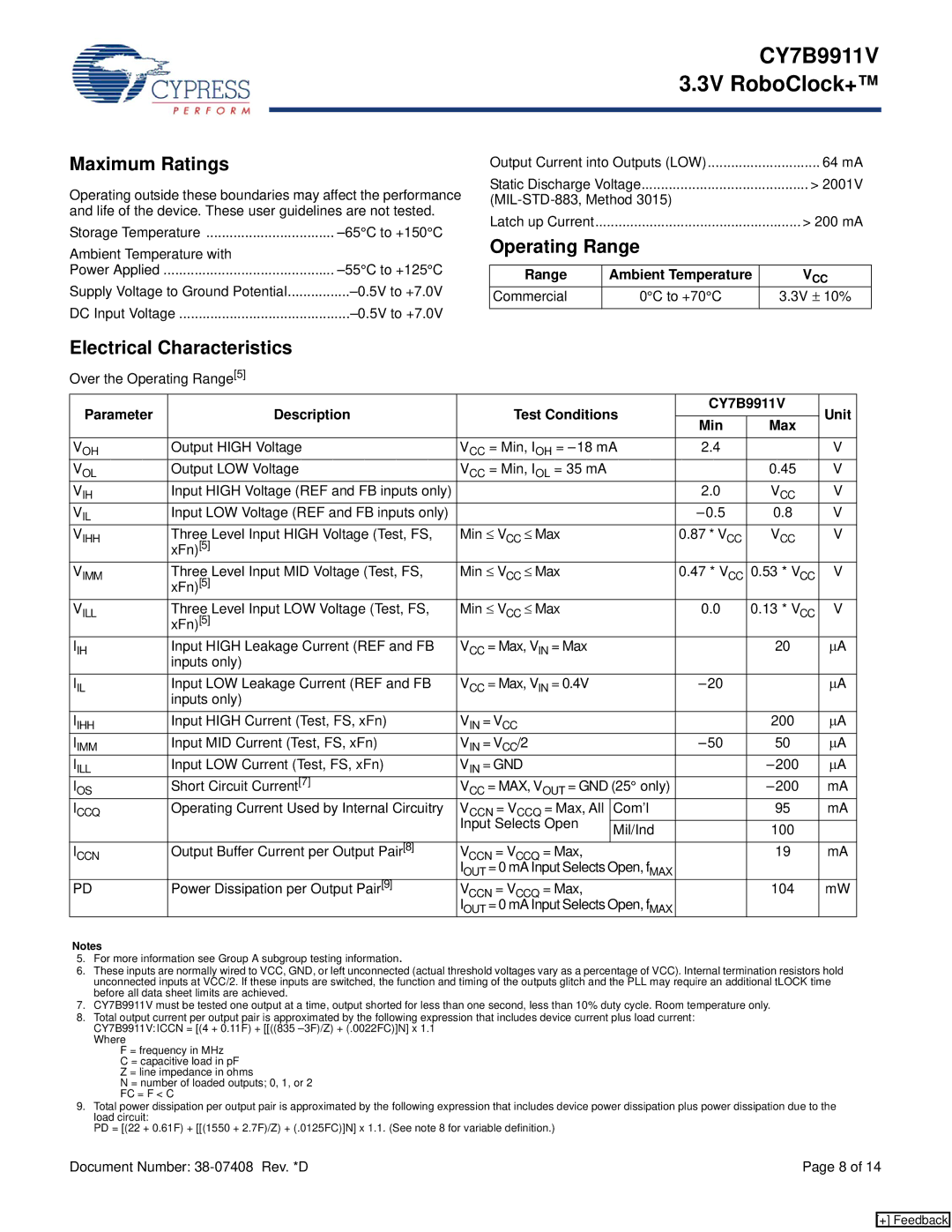
CY7B9911V 3.3V RoboClock+™
Maximum Ratings
Operating outside these boundaries may affect the performance and life of the device. These user guidelines are not tested.
Storage Temperature | |
Ambient Temperature with |
|
Power Applied | |
Supply Voltage to Ground Potential | |
DC Input Voltage |
Output Current into Outputs (LOW) | 64 mA | |
Static Discharge Voltage | > 2001V | |
| ||
Latch up Current |
| > 200 mA |
Operating Range |
| |
|
|
|
Range | Ambient Temperature | VCC |
Commercial | 0°C to +70°C | 3.3V ± 10% |
|
|
|
Electrical Characteristics
Over the Operating Range[5]
Parameter | Description |
|
|
| Test Conditions | CY7B9911V | Unit | |||
|
|
| Min | Max | ||||||
|
|
|
|
|
|
|
|
| ||
|
|
|
|
|
| |||||
VOH | Output HIGH Voltage | VCC = Min, IOH = | 2.4 |
| V | |||||
VOL | Output LOW Voltage | VCC = Min, IOL = 35 mA |
|
| 0.45 | V | ||||
VIH | Input HIGH Voltage (REF and FB inputs only) |
|
|
|
|
|
| 2.0 | VCC | V |
VIL | Input LOW Voltage (REF and FB inputs only) |
|
|
|
|
|
| 0.8 | V | |
VIHH | Three Level Input HIGH Voltage (Test, FS, | Min ≤ VCC ≤ Max |
| 0.87 * VCC | VCC | V | ||||
| xFn)[5] |
|
|
|
|
|
|
|
|
|
VIMM | Three Level Input MID Voltage (Test, FS, | Min ≤ VCC ≤ Max |
| 0.47 * VCC | 0.53 * VCC | V | ||||
| xFn)[5] |
|
|
|
|
|
|
|
|
|
VILL | Three Level Input LOW Voltage (Test, FS, | Min ≤ VCC ≤ Max |
| 0.0 | 0.13 * VCC | V | ||||
| xFn)[5] |
|
|
|
|
|
|
|
|
|
IIH | Input HIGH Leakage Current (REF and FB | VCC = Max, VIN = Max |
|
| 20 | μA | ||||
| inputs only) |
|
|
|
|
|
|
|
|
|
IIL | Input LOW Leakage Current (REF and FB | VCC = Max, VIN = 0.4V |
|
| μA | |||||
| inputs only) |
|
|
|
|
|
|
|
|
|
IIHH | Input HIGH Current (Test, FS, xFn) | VIN = VCC |
|
|
| 200 | μA | |||
IIMM | Input MID Current (Test, FS, xFn) | VIN = VCC/2 |
|
| 50 | μA | ||||
IILL | Input LOW Current (Test, FS, xFn) | VIN = GND |
|
|
| μA | ||||
I | Short Circuit Current[7] | V | CC | = MAX, V | = GND (25° only) |
| mA | |||
OS |
|
|
|
| OUT |
|
|
|
| |
ICCQ | Operating Current Used by Internal Circuitry | VCCN = VCCQ | = Max, All | Com’l |
| 95 | mA | |||
|
| Input Selects Open |
|
|
|
| ||||
|
| Mil/Ind |
| 100 |
| |||||
|
|
|
|
|
|
|
|
| ||
|
|
|
|
|
|
|
|
| ||
ICCN | Output Buffer Current per Output Pair[8] | VCCN | = VCCQ | = Max, |
|
| 19 | mA | ||
|
| IOUT = 0 mA Input Selects Open, fMAX |
|
|
| |||||
PD | Power Dissipation per Output Pair[9] | V |
|
| = V | = Max, |
|
| 104 | mW |
|
| CCN | CCQ |
|
|
|
|
| ||
|
| IOUT = 0 mA Input Selects Open, fMAX |
|
|
| |||||
Notes
5. For more information see Group A subgroup testing information.
6. These inputs are normally wired to VCC, GND, or left unconnected (actual threshold voltages vary as a percentage of VCC). Internal termination resistors hold unconnected inputs at VCC/2. If these inputs are switched, the function and timing of the outputs glitch and the PLL may require an additional tLOCK time before all data sheet limits are achieved.
7. CY7B9911V must be tested one output at a time, output shorted for less than one second, less than 10% duty cycle. Room temperature only.
8. Total output current per output pair is approximated by the following expression that includes device current plus load current: CY7B9911V:ICCN = [(4 + 0.11F) + [[((835
Where
F = frequency in MHz
C = capacitive load in pF
Z = line impedance in ohms
N = number of loaded outputs; 0, 1, or 2 FC = F < C
9. Total power dissipation per output pair is approximated by the following expression that includes device power dissipation plus power dissipation due to the load circuit:
PD = [(22 + 0.61F) + [[(1550 + 2.7F)/Z) + (.0125FC)]N] x 1.1. (See note 8 for variable definition.)
Document Number: | Page 8 of 14 |
[+] Feedback
